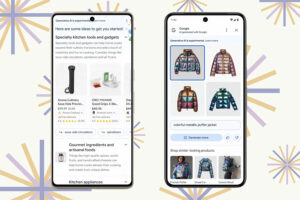Google launches new visual search ads for retailers
Google is launching a new ad format called Showcase Shopping ads, which are designed to help retail brands reach people searching for broad product terms with visual displays of their products.
The new ad format will allow brands to reach the people behind broad product search queries with a range of products that match the category, instead of a single product ad that might not match what the user had in mind.
Google’s new shopping ad format comes as consumers are increasingly using mobile devices to shop. Even in stores, consumers are increasingly using their phones to compare prices, get additional information, and find inspiration for their purchases.
Retailers looking to reach consumers searching Google for broad product categories may now find it easier to advertise effectively to them. While Google would previously show very specific product ads for broad product searches, the internet search giant will now enable brands to present consumers with a range of products that fit the search description.
“To start, all merchants running Shopping Campaigns in the US, UK, and Australia will be eligible to have their products automatically appear in Showcase ads in the coming weeks,” Jonathan Alferness, VP of Product Management at Google, wrote in the blog post. “And for merchants who would like to customize how their brand and products appear, we’re experimenting with a premium version that allows merchants to curate the experience.”
Product images from advertisers will appear in the search results, enabling brands to visually display their offerings and allow users to click through to a page with product information. Google found 44% of consumers use images to “find ideas” while shopping online, while mobile searches related to finding the “best” product are up more than 50% over last year, Ad Week reports.
As of 2016, 34% of U.S. online retail purchases happen on mobile, Google’s Alferness said at the Shoptalk 2016 retail conference in May. “Mobile has completely changed the way all of us shop and the way we live,” Alferness said. “We no longer go online. In fact, we’re living online.”
-g8v16m.png)




